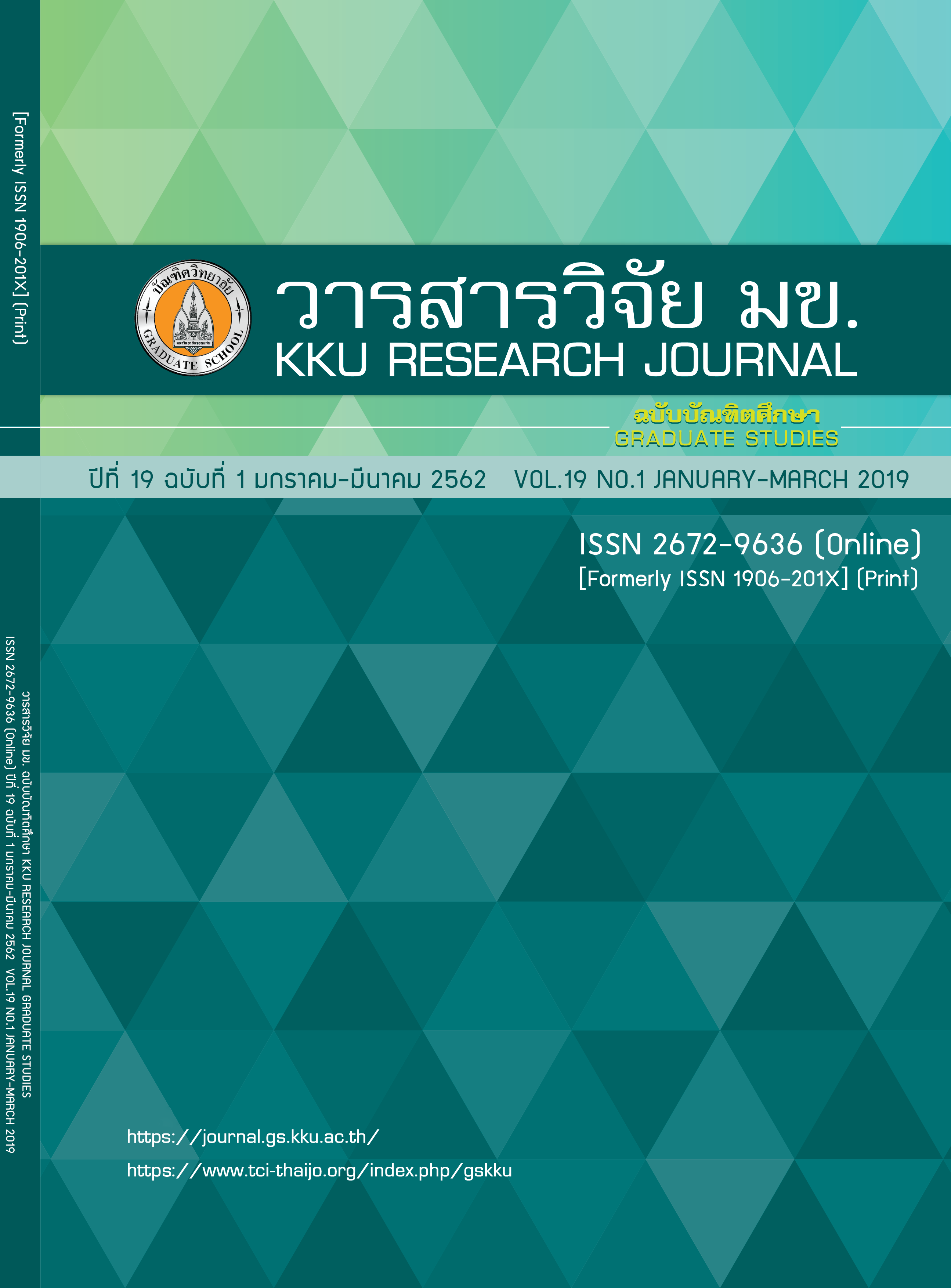Bioactive Film Based on Polyvinyl Alcohol/Starch Enriched with Antioxidants from Extracted Spent Coffee Ground and Citric Acid
Keywords:
Bioactive film, Antimicrobial activity, Citric acidAbstract
In this study, properties of bioactive starch powder/ polyvinyl alcohol film incorporated extracted spent coffee ground (St/PVA) and various content of citric acid were investigated. All samples were exposed to humidity at 32, 43, 52 and 75% for 7 days before testing of their properties. The addition of citric acid substantially decreased isotherm of moisture sorption as well as improved water resistant. The moisture content and total solubility index decrease up to 8.11-8.81% and 20.60-25.06%, respectively. The St/PVA incorporated with 10 wt% of citric acid showed the highest glass transition temperature and melting temperature due to the good compatibility of polymer matrix. The inhibition of microbial by incubation with fresh apple for 7 days indicated the number of microbial of St/PVA incorporated 30 wt% citric acid showed the lowest value at 10 CFU/g which was lower than those of St/PVA and commercial packaging. Based on these results, the St/PVA incorporated citric had high potential for utilize as bioactive and biodegradable food packaging to control food quality and extent shelf life.
References
2. Seligraa PG, Jaramillo CM, Famáa L, Goyanes S. Biodegradable and non-retrogradable eco-films based on starch–glycerol with citric acid as crosslinking agent. Carbohydr Polym. 2016; 138: 66-74.
3. Tang X, Alavi S. Structure and physical properties of starch/polyvinylalcohol/laponite RD nanocomposite films. J Agric Food Chem. 2012; 60 (2012): 1954–1962.
4. Ramisa X, Cadenatoa A, Sallaa JM, Moranchoa JM, Vallésb A, Contat L, et al. Thermal degradation of polypropylene/starch-based materials with enhanced biodegradability. Polym Degrad Stab. 2004; 483–491.
5. Follain N, Joly C, Dole P, Bliard C. Properties of starch based blends. Part 2. Influence of poly vinyl alcohol addition and photocrosslinking on starch based materials mechanical properties. Carbohydr Polym. 2005; 60(2): 185-192.
6. Reddy N, Yang Y. Citric acid cross-linking of starch films. Food Chem. 2010; 118(3): 702-711.
7. Department of industrial works, Citric acid. 2559. Thai.
8. Jiugao Y, Ning W, Xiaofei M. The Effects of Citric Acid on the Properties of Thermoplastic Starch Plasticized by Glycerol. Starch-Stärke. 2005; 57(10): 494-504.
9. Yoon SD, Chough SH, Park HR. Properties of starch-based blend films using citric acid as additive II. J Appl Polym Sci. 2006; 100(3): 2554-2560.
10. Priya B, Gupta VK, Pathania D, Singha AS. Synthesis, characterization and antibacterial activity of biodegradable starch/PVA composite films reinforced with cellulosic fibre. Carbohydr Polym. 2014; 109: 171-179.
11. Parkar SG, Stevenson DE, Skinner MA. The potential influence of fruit polyphenols on colonic microflora and human gut health. Int J Food Microbiol. 2008; 124(3): 295-298.
12. Trongchean K. Characterization of cassava starch foam composite containing with byproducts of spent ground coffee and essential oil. Khon Kaen University: Master of Engineering Thesis in Chemical Engineering, Graduate School. 2017.
13. Monente C. Coffee and spent coffee extracts protect against cell mutagens and inhibit growth of food-borne pathogen microorganisms. J Funct Foods. 2015; 12: 365-374.
14. FDA, Bacteriological Analytical Manual—BAM, 1995. 8th ed. Gaithersburg, USA.
15. Abdillahi H, Chabrat E, Rouilly A, Rigal L. Influence of citric acid on thermoplastic wheat flour/poly(lactic acid) blends II. Barrier properties and water vapor sorption isotherms. Ind Crops Prod. 2013; 104-111.
16. Russell NJ, Gould JW. Food Preservatives. Springer US. 2012.
17. Demirci A, Ngadi MO. Microbial Decontamination in the Food Industry: Novel Methods and Applications. Elsevier Science. 2012.
18. Lou Z, Wang H, Zhu S, Ma C, Wang Z. Antibacterial activity and mechanism of action of chlorogenic acid. J Food Sci. 2011; 76(6): M398-M403.
19. Soliva-Fortuny RC, Martı́n-Belloso O. New advances in extending the shelflife of fresh-cut fruits. J Food Sci Technol. 2003; 14; 341–353.
20. Shi R, Bi J, Zhang Z, Zhu A, Chen D, Zhou X. The effect of citric acid on the structural properties and cytotoxicity of the polyvinyl alcohol/starch films when molding at high temperature. Carbohydr Polym. 2008; 74(4): 763-770.



